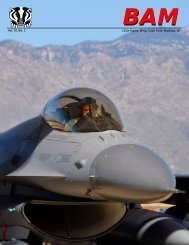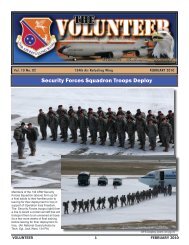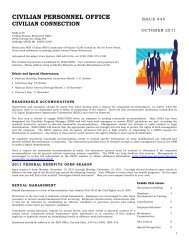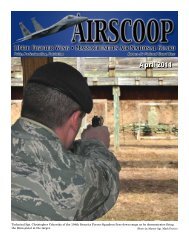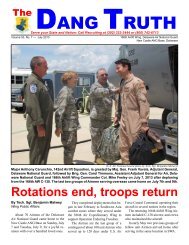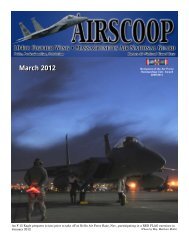August - 153rd Airlift Wing, Wyoming Air National Guard
August - 153rd Airlift Wing, Wyoming Air National Guard
August - 153rd Airlift Wing, Wyoming Air National Guard
Create successful ePaper yourself
Turn your PDF publications into a flip-book with our unique Google optimized e-Paper software.
WyANG EM techniciansexpertly prepared for duty4 The <strong>Guard</strong>ian • <strong>August</strong> 2012The <strong>Guard</strong>ian • <strong>August</strong> 2012 5U.S. <strong>Air</strong> Force photos/Staff Sgt. Natalie StanleyThe <strong>Air</strong>men of the <strong>153rd</strong>Civil Engineer EmergencyManagement team workhard to ensure the members of the<strong>153rd</strong> <strong><strong>Air</strong>lift</strong> <strong>Wing</strong> and the surroundingcommunities are trainedand prepared in the event of ahazardous material incident.Emergency Management careerfield members go through extensiveand continuous training throughouttheir careers.First, they attend a 16-week technicalschool at Fort Leonard Wood,Mo., which includes: <strong>Air</strong> ForceDisaster PreparednessProgram, organization and responsibilities;readiness disaster responseplanning; and chemical, biological,radiological, nuclear and high-yieldexplosives training. During training,students also go through a live-agentchamber.“We need to be able to stand infront of a class and tell them thatwe have been exposed to live agentsand that we are living proof that thegear that they are wearing and thethings we are teachingactually work,” said Master Sgt.Ingvar Ingvarsson, 153 AW InstallationEmergency Managementsuperintendent.Emergency Managementtechnicians learn to respond tohazardous material incidents fromthe lowest level, hazmat awareness- identifying the problem, to technicianlevel - identifying the problemand responding accordingly. Duringthe technician level class, EMsreceive training on self-containedbreathing apparatus and the LevelA Suit - a fully encapsulated suit thatprovides the highest level ofprotection against vapors, gases,mists and particles.Once back at home station, membersaccomplish a great deal of inhousetraining and work one-on-onewith their supervisors to stay up todate in a changing career field andlearn how to convey that knowledgeto the base populous.Master Sgt. Kelly Bouquet,emergency management technician,trains the <strong>Air</strong>men in the emergencymanagement shop and helps themdevelop a teaching style that worksfor them.“We want these guys to be sofamiliar with the information that itjust flows,” said Bouquet. “We getthe <strong>Air</strong>men to develop their ownteaching style so that they’recomfortable and a slide showdoesn’t become a crutch to them.”Many EM members were recruitedfor the career field basedon expressed desire to instruct andteach and the career field takes onlythose with a high Armed ServicesVocational Aptitude Battery testscore.“I have an associate’s in teachingand being able to be an instructoris what drew me to this careerinitially,” said Senior <strong>Air</strong>man ErinSwingholm, emergency managementtechnician. “I like teachingsomething nobody wants to do, puton or deal with, and try making itfun.”Training the base populous forwartime is just one aspect of the EMtechnician’s job. They also overseethe regulations for base emergencymanagement plans, act as firstresponders for hazmat incidentsand both state and local respondersuse their expertise when needed.“Emergency management is afull-spectrum operation,” saidIngvarsson, who has been in theemergency management career fieldsince 2000 and joined the 153 CESin February 2012. “The civilsupport team will go in and eitherdeny or confirm the presence of achemical and that’s as far as they’llgo, but emergency managementgoes beyond that; we docomprehensive emergency management.”Although the training is intenseand the hours can be long, the eightmembers of the EM shop find it importantto focus on coming togetherand developing the team’s moraleon and off duty.“We see our shop as a close-knitfamily,” said Swingholm, who hasbeen an EM technician for morethan four years. “If there’s anythinggoing on, everyone is comfortablewith sharing that with at least oneperson, if not the whole shop. Weall pull together and support oneanother.”Ingvarsson and Bouquet creditthe success of the 153 CESEmergency Management Officeto the hard work and talent of the<strong>Air</strong>men.“When I came here I wasn’texpecting the quality of emergencymanagers this shop already had,”said Ingvarsson. “I couldn’t beprouder of our crew and theircapabilities.”





